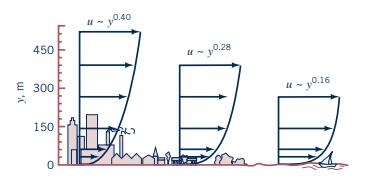The United Nations Building in New York is approximately (87.5 mathrm{~m}) wide and (154 mathrm{~m}) tall. (a)
Question:
The United Nations Building in New York is approximately \(87.5 \mathrm{~m}\) wide and \(154 \mathrm{~m}\) tall.
(a) Determine the drag on this building if the drag coefficient is and the wind speed is a uniform \(20 \mathrm{~m} / \mathrm{s}\).
(b) Repeat your calculations if the velocity profile against the building is a typical profile for an urban area (see Problem 9.21) and the wind speed halfway up the building is \(20 \mathrm{~m} / \mathrm{s}\).
Problem 9.21
An atmospheric boundary layer is formed when the wind blows over the Earth's surface. Typically, such velocity profiles can be written as a power law: \(u=a y^{n}\), where the constants \(a\) and \(n\) depend on the roughness of the terrain. As is indicated in Fig. P9.21, typical values are \(n=0.40\) for urban areas, \(n=0.28\) for woodland or suburban areas, and \(n=0.16\) for flat open country (Ref. 23).
(a) If the velocity is \(20 \mathrm{ft} / \mathrm{s}\) at the bottom of the sail on your boat \((y=4 \mathrm{ft}\) ), what is the velocity at the top of the mast \((y=\) \(30 \mathrm{ft}\) )?
(b) If the average velocity is \(10 \mathrm{mph}\) on the tenth floor of an urban building, what is the average velocity on the sixtieth floor?
Figure P9.21

Step by Step Answer:

Munson Young And Okiishi's Fundamentals Of Fluid Mechanics
ISBN: 9781119080701
8th Edition
Authors: Philip M. Gerhart, Andrew L. Gerhart, John I. Hochstein





